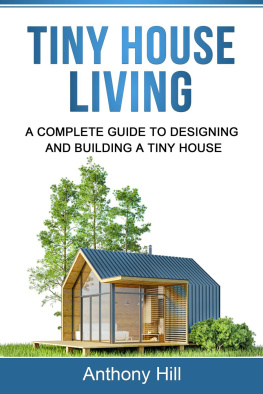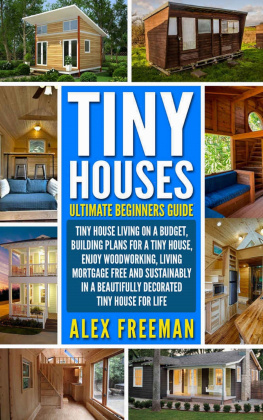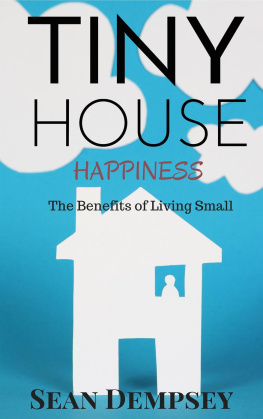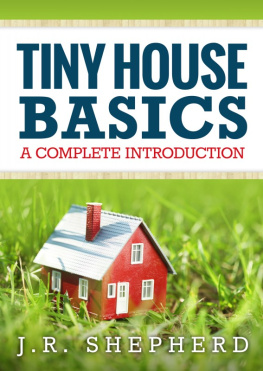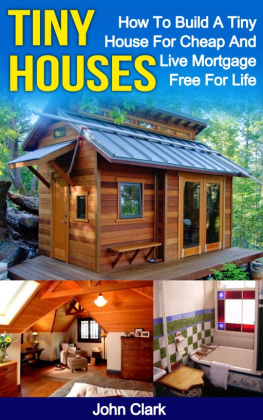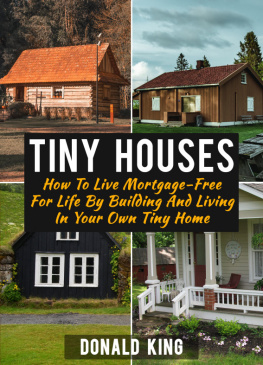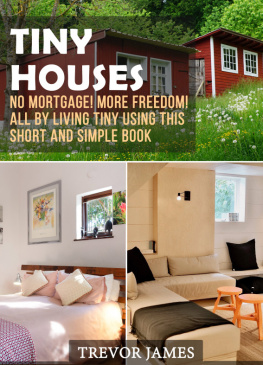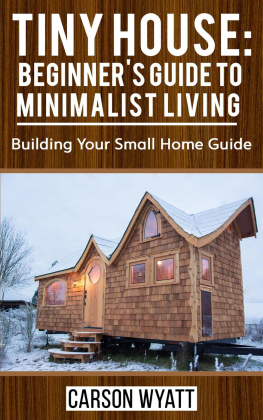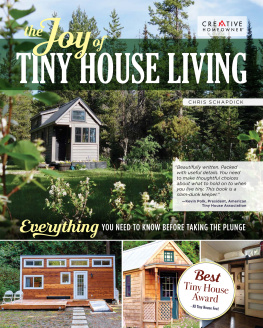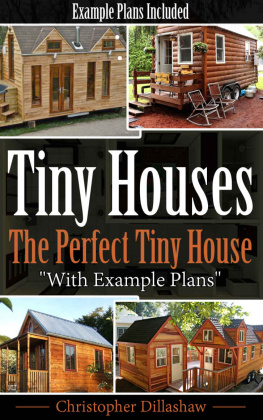Tiny House Living
A Complete Guide to Designing and Building a Tiny House
Anthony Hill
Table of Contents
T he tiny house revolution is quickly taking over the world. A simple internet search of the term tiny-house instantaneously generates over 1-billion results! The tiny house revolution is extremely popular all across the globe. It consists of people from all walks of lifecouples, singles, nomads, and the elderly. Small spaces have become popular because they are eco-friendly, cost-effective, and provide people with the opportunity to make their dream spaces come to life. Take a moment to think about your favorite spaces growing up and what weird and wacky ideas you had about design. Think about spaces with interesting concepts and unorthodox takes on functionality. Smaller homes are allowing people the opportunity to make these spaces a reality. These homes are a form of creative expression because every home is tailored to the persons needs. Whether you dreamed of staying in a dollhouse, a luxurious mansion, or a man cave where no one would bother you, compact spaces are the solution. The beauty of smaller spaces lies in their ability to fit into everyones lifestyle. If these spaces have been out of your reach because of the cost, then downsizing is an easy way to make your dream a reality. They allow people the opportunity to take chances with design and think up alternative approaches to roofs and exteriors.
Smaller houses are shaking up ideas around conventional housing. It is liberating people and introducing them to a different way to live. Whether its an article online or a new TV show on a streaming platform, small-scale houses are a hot topic. Conversations about compact houses are usually met with two reactions: shock steaming from disbelief about how anyone would choose to live this way, or alternatively, complete amazement. The fact that youre reading this book leads me to believe that you form part of the latter group of people who are completely enthralled by the idea of living in a smaller space. There is space for everyone in this community. Small-scale homes are popping up everywhere with more people exploring its possibilities every day. Small-scale home communities are popping up rapidly, with like-minded people choosing to live in the same place. Tiny homes are whatever you choose to make themwhether it's your residence, travel home, or rental property. Smaller meets everyone's needs!
In a community as vast as this, you need a guide that will assist you through every step of making your dream home a reality. Thankfully this is that guide. We will cover every detail of planning and building your tiny home from what materials to use to ensuring functionality. In addition, we will explore the benefits, financial implications, and different types of small-scale houses. Think of this as a guide packed with everything you need to know about going tiny. Lets begin!
Chapter 1: Tiny Homes 101
F irstly, we will answer the most important question: What is a tiny house? There are different opinions on what the requirements are for a space to be considered tiny, but the widely accepted opinion is anything between 60-400 square feet. Small houses date back to the earliest human dwellings. These homes were a necessity for hunter-gatherers as they used them as temporary shelters. Compact spaces evolved from caves, tents, and cottages to what we now know as the modern-day tiny house. We have come a long way from hunting to ensure our existence but the fascination with small spaces has only grown with time. The idea of creating a mobile space provides people with housing security and freedom.
The smallest tiny houses are roughly the size of four treadmills placed side by side. The next time you are at the gym, take a moment to consider living in that amount of space. It might sound like a dream, a welcomed challenge, or nearly impossible. Luckily, there is room for you to pick a space ideal for your needs. You are free to use the standard measurements as a guide for your customized space. Switching from an average-sized traditional home of 2600 square feet or a standard 800 square foot apartment to a smaller space requires research and a shift in your mindset. Downsizing can occur in stages in order to ease you into the transition. Walking through ready-made tiny homes will offer you perspective and allow you to compare the different sizes.
There are two types of small-scale homes: mobile and stationary. Mobile homes are legally classified as recreational vehicles. What sets smaller houses apart from conventional recreational vehicles is their appearance. They are built on trailers and resemble miniature versions of standard houses. The houses are designed to feel homey despite their size. The laws in your state around mobile homes will guide your trailer selection and the size of your home. The maximum measurements for mobile tiny homes are a height of 13.5 feet, a width of 8.5 feet, and a total length of 40 feet. This size allows you to travel with your home without a permit.
Pro tip: Remember when you are designing your home that the total height of your home should be no higher than 13.5 feet when placed on the trailer. This allows you to travel freely without the fear of colliding with bridges.
When you are constructing your home on a trailer you need to think about the weight limit of your towing vehicle. Your home needs to distribute weight equally to be aerodynamic. I suggest avoiding overloading the rear of your trailer to ensure that your home does not scrape the roads when you are traveling over bumps. Mobile houses bring on the additional challenge of deciding where your home will reside the majority of the time. You have the option of parking it in a tiny house community for a monthly fee. This option is perfect for individuals who hope to travel with their homes. You wouldnt be limited by a long-term lease and are free to travel to different cities as you see fit. If you are seeking a long-term option, you can purchase a lot to park your mobile house. This is ideal for individuals who reside in one area for the majority of the year but still want the option to travel with their home. The final option is parking your home in a relative or friends driveway. This is a cost-effective solution for mobile homeowners.
Small-scale mobile homes come with their advantages and disadvantages. The primary advantage is your ability to travel with your home. There are three disadvantages of mobile homes: depreciation, travel costs, and the precautions that you are required to take when traveling. Your home will depreciate because it is legally considered a vehicle. You should also consider the cost of traveling with your home. You need to budget for increased fuel expenditure and the cost to park your vehicle depending on your preferred option. Your home also needs to be able to endure constant travel; this can cause premature wear and tear. I suggest budgeting for unexpected harm caused to your home if you are constantly traveling. Travelling can also impact the interior of your home. The constant movement shifts your belongings can cause breakage and unexpected damage.
Next page
